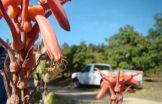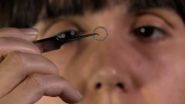(Press-News.org) The search for the origin of modern human behaviour and technological advancement among our ancestors in southern Africa some 70 000 years ago, has taken a step closer to firmly establishing Africa, and especially South Africa, as the primary centre for the early development of human behaviour.
A new research paper by renowned Wits University archaeologist, Prof. Christopher Henshilwood, is the first detailed summary of the time periods he and a group of international researchers have been studying in South Africa: namely the Still Bay techno-traditions (c. 75 000 – 70 000 years) and the Howiesons Poort techno-tradition (c. 65 000 – 60 000 years).
The paper, entitled Late Pleistocene Techno-traditions in Southern Africa: A Review of the Still Bay and Howiesons Poort, c. 75 ka, has been published online in the Journal of World Prehistory on 6 November 2012.
Henshilwood says these periods were significant in the development of Homo sapiens behaviour in southern Africa. They were periods of many innovations including, for example, the first abstract art (engraved ochre and engraved ostrich eggshell); the first jewellery (shell beads); the first bone tools; the earliest use of the pressure flaking technique, that was used in combination with heating to make stone spear points and the first probable use of stone tipped arrows launched by bow.
"All of these innovations, plus many others we are just discovering, clearly show that Homo sapiens in southern Africa at that time were cognitively modern and behaving in many ways like ourselves. It is a good reason to be proud of our earliest, common ancestors who lived and evolved in South Africa and who later spread out into the rest of the world after about 60 000 years," says Henshilwood.
The research also addresses some of the nagging questions as to what drove our ancestors to develop these innovative technologies. According to Henshilwood answers to these questions are, in part, found in demography and climate change, particularly changing sea levels, which were major drivers of innovation and variability in material culture.
This paper is just the latest to come from Henshilwood and his teams' research on African archaeology that revolutionised the idea that modern human behaviour originated in Europe after about 40 000 years ago. There is increasing evidence for an African origin for behavioural and technological modernity more than 70 000 years ago and that the earliest origin of all Homo sapiens lies in Africa with a special focus in southern Africa.
Henshilwood writes: "In just the past decade our knowledge of Homo sapiens behaviour in the Middle Stone Age, and in particular of the Still Bay and Howiesons Poort, has expanded considerably. With the benefit of hindsight we may ironically conclude that the origins of 'Neanthropic Man', the epitome of behavioural modernity in Europe, lay after all in Africa."
INFORMATION:
ABOUT PROF. CHRISTOPHER HENSHILWOOD:
In the past decade the research led by Henshilwood and a team of multi-disciplinary researchers has turned around, within a decade, the widely held idea that modern human behaviour originated in Europe after about 40 ka ago. With his research team he increasingly provides evidence for an African origin for behavioural and technological modernity more than 70 000 years ago and has decisively shown that Africa is the birthplace for early development on modern human cognition. He has thus restored a pride in the place that Africa played in the evolution of Homo sapiens and has been honoured for this by past South African Presidents Nelson Mandela and Thabo Mbeki and through the many awards and invitations that he has received nationally and internationally.
His more than 40 publications since 2001, including four in Science (three as 1st author) in 2002, 2004, 2010, 2011 and review articles in Science, 2009 and Nature, 2012, demonstrate that southern Africa was a primary centre for the early development of human behaviour mediated by symbols. Since 1999 Henshilwood has published more than 40 papers in leading peer reviewed journals, volumes and books on aspects of African archaeology, especially the Middle and Later Stone Age; on the origins of language and symbolism; the effects of climatic variation on human demographics, and the epistemology of early behavioural evolution.
In 2010 Henshilwood was rated as an A1 researcher by the European Research Council and awarded a R25 million, 5 year research grant (2010 – 2015) as Principal Investigator to carry out research on the Middle Stone Age in South Africa. This award is shared in part with Wits University. In 2012 his Research Chair at Wits University on the "Origins of Modern Human Behaviour" was renewed for 5 years. Over the past 5 years Henshilwood has made a major contribution to archaeological research at Wits University and the University of Bergen in Norway and also at a national and international level.
In 1999 Henshilwood founded the African Heritage Research Institute in Cape Town, South Africa, under the patronage of former president Nelson Mandela, to promote archaeological research on the origins of H. sapiens in southern Africa. In 2001 he was honoured at the opening of the South African parliament by former president Thabo Mbeki for his research in African archaeology. In 2005 he was awarded the Chevalier dans l'Ordre des Palmes Académiques, by the French Prime Minister for distinguished contributions to French education and culture within a South African context. He was accepted as a member of the South African Academy of Science in 2009.
Africa's Homo sapiens were the first techies
2012-12-05
ELSE PRESS RELEASES FROM THIS DATE:
Discovery of 100 million-year-old regions of DNA shows short cut to crop science advances
2012-12-05
Scientists have discovered 100 million-year-old regions in the DNA of several plant species which could hold secrets about how specific genes are turned 'on' or 'off'.
The findings, which are hoped will accelerate the pace of research into crop science and food security, are detailed by University of Warwick researchers in the journal The Plant Cell.
By running a computational analysis of the genomes of the papaya, poplar, Arabidopsis and grape species, scientists have uncovered hundreds of conserved non-coding sequences which are found in the DNA of all four species.
These ...
Small patches of native plants help boost pollination services in large farms
2012-12-05
A combined team of scientists from Europe and South Africa (Luísa G. Carvalheiro (University of Leeds, UK & Naturalis Biodiversity Research Centre, Netherlands), Colleen Seymour and Ruan Veldtman (SANBI, South Africa) and Sue Nicolson (University of Pretoria)) have discovered that pollinator services of large agriculture fields can be enhanced with a simple cost-effective measure, that involves the creation of small patches of native plants within fruit orchards.
"Mango farmers in South Africa are aware of the pollination limitation of this crop and invest a substantial ...
New technique to deliver stem cell therapy may help damaged eyes regain their sight
2012-12-05
In research published in the journal Acta Biomaterialia, researchers from the University of Sheffield describe a new method for producing membranes to help in the grafting of stem cells onto the eye, mimicking structural features of the eye itself. The technology has been designed to treat damage to the cornea, the transparent layer on the front of the eye, which is one of the major causes of blindness in the world.
Using a combination of techniques known as microstereolithography and electrospinning, the researchers are able to make a disc of biodegradable material which ...
An inadequate diet during pregnancy predisposes the baby to diabetes
2012-12-05
Experts already know that pregnant women should not eat for two. A study now insists on the importance of a healthy diet as a way of avoiding increased insulin and glucose levels in the child, both of which are indicators of diabetes and metabolic syndrome risk.
Maternal diet quality during pregnancy is fundamental to foetal growth as well as insulin and glucose levels at birth. Such indications warn of the possible predisposition to suffer from illnesses like diabetes and metabolic syndrome.
The study was headed by the Complutense University of Madrid and published ...
See-through 'MitoFish' opens a new window on brain diseases
2012-12-05
Scientists have demonstrated a new way to investigate mechanisms at work in Alzheimer's and other neurodegenerative diseases, which also could prove useful in the search for effective drugs. For new insights, they turned to the zebrafish, which is transparent in the early stages of its life. The researchers developed a transgenic variety, the "MitoFish," that enables them to see – within individual neurons of living animals – how brain diseases disturb the transport of mitochondria, the power plants of the cell.
Neurodegenerative diseases such as Alzheimer's, Parkinson's, ...
Sustainable business innovation adds firms' market value
2012-12-05
Sustainable business innovation is good business; researchers from Aalto University, Finland have proved. The researchers tested how sustainability business innovations and the market value of companies in the construction sector are connected. The study is a first of its kind. An event study model was used to analyse large construction sector companies in several European countries as well as Australia.
The most important finding of the study is that a positive and statistically significant association exists between sustainability innovation announcements and the market ...
Creativity and linguistic skills important for immersion in World of Warcraft
2012-12-05
The sense of immersion in role-play and computer games is sometimes viewed as dangerous, as players' strong perceptions of fictional worlds are assumed to make them lose contact with reality. On the other hand, players' immersion also implies a potential for improved learning, since it enables them to 'experience' new places and historical eras. Yet a new study from the University of Gothenburg, Sweden, shows that immersion in online role-play games requires a lot of hard work.
Gaming researcher Jonas Linderoth, at the Department of Education, Communication and Learning, ...
Adult antiviral drug effective in suppressing hepatitis B in teens
2012-12-05
A recent clinical trial found that the adult antiviral drug, tenofovir disoproxil fumarate (tenofovir DF), is safe and effective in treating adolescents with hepatitis B virus (HBV). Trial results published in the December issue of Hepatology, a journal of the American Association for the Study of Liver Diseases (AASLD), show that tenofovir DF suppressed HBV in 89% of pediatric participants.
Chronic HBV is a major health burden that studies estimate affects 350 million people worldwide, with 600,000 deaths attributed to this chronic disease. The Centers for Disease Control ...
In US first, Johns Hopkins surgeons implant brain 'pacemaker' for Alzheimer's disease
2012-12-05
Researchers at Johns Hopkins Medicine in November surgically implanted a pacemaker-like device into the brain of a patient in the early stages of Alzheimer's disease, the first such operation in the United States. The device, which provides deep brain stimulation and has been used in thousands of people with Parkinson's disease, is seen as a possible means of boosting memory and reversing cognitive decline.
The surgery is part of a federally funded, multicenter clinical trial marking a new direction in clinical research designed to slow or halt the ravages of the disease, ...
Reading history through genetics
2012-12-05
New York, NY—December 5, 2012—Computer scientists at Columbia's School of Engineering and Applied Science have published a study in the November 2012 issue of The American Journal of Human Genetics (AJHG) that demonstrates a new approach used to analyze genetic data to learn more about the history of populations. The authors are the first to develop a method that can describe in detail events in recent history, over the past 2,000 years. They demonstrate this method in two populations, the Ashkenazi Jews and the Masai people of Kenya, who represent two kinds of histories ...




